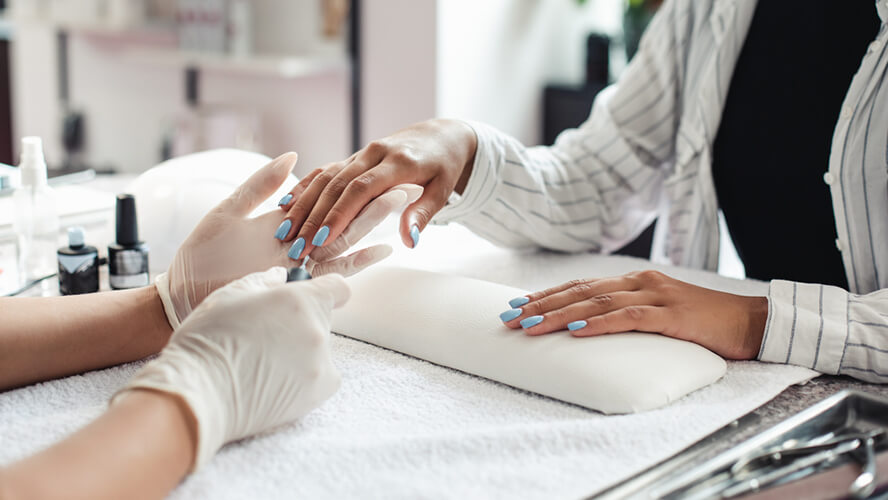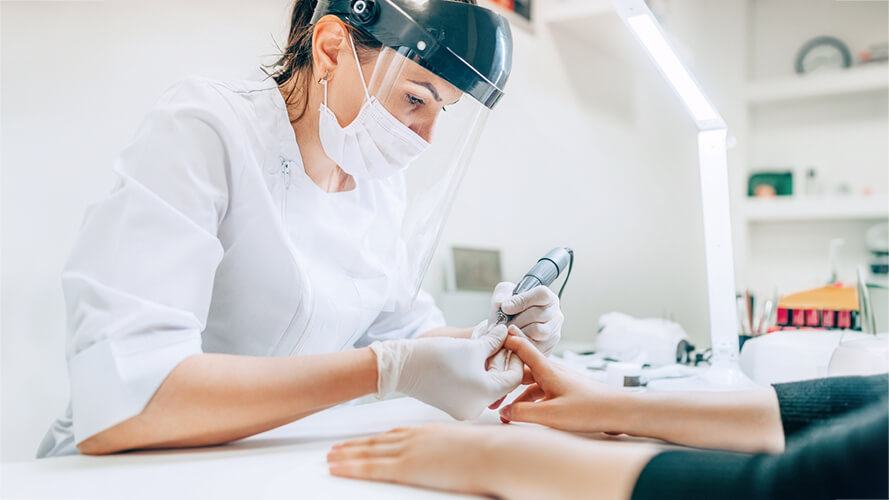Nail technician health hazards: What you need to know
Many nail salon customers are paying increasing attention to the condition of their salons—the sanitation practices, the ingredients used in products and the indoor air quality. When recent research connected the UV light used in drying gel manicures to cell damage, some folks even rethought their routines entirely.
But for the more than 130,000 nail technicians in the U.S., the potentially hazardous conditions of salons are a day in, day out reality. Manicurists use steady hands, intense focus and countless hours of experience to shape and polish nails, buff rough skin away, soothe sore muscles, and even design creative art in miniature. However, their work is also intensely physical, involving bending, stooping and repetitive movements. Chemical hazards from polishes, acrylics and glues fill the salon environment. And biological health hazards from blood and skin exposure are a real risk.
What precautions should nail technicians take in their work, and do independent contractor manicurists have protections at all?
Chemical risks in nail salons
Visit a Sephora, Ulta or corner drug store, and you’ll spot polishes and nail products advertising their natural ingredients or “3-free” formulas. The chemical mixture sometimes known as the “toxic trio” is common in many standard products, and the chemicals included pose the greatest risk to salon worker health:
- Toluene, present in polish and fingernail glue, can cause dizziness or irritate the eyes, throat and lungs. It can dry out or crack the skin and damage the liver and kidneys. It’s also linked to birth defects and low birth weight, making it especially risky to workers who are pregnant or plan to become so.
- Formaldehyde, used in nail polish and nail hardener, is carcinogenic. It can irritate the eyes, skin and throat and cause asthma-like symptoms.
- Dibutyl phthalate, present in nail polish and hardener, is linked to reproductive issues in animals.
Even if salons use 3-free polishes, however, workers may face exposures to other chemicals like acetone (polish remover), acetonitrile (fingernail glue remover), butyl acetate (nail polish and remover), ethyl methacrylate (artificial nail liquid) and others. Workers are also exposed to acrylic dust from artificial nails.
Lessening salon chemical exposures
For most salons, ventilation is the key to lowering staff chemical exposures. Salons should keep ceiling vents on, use exhaust systems and open doors and windows to improve indoor air quality. Ventilated tables can help catch dust at each station. Stations should also have metal, lidded trash cans, which help stop chemicals on soaked cotton balls, tissues or swabs from evaporating into the air.
Salons can also choose safer products, avoiding items containing the toxic trio. Workers transferring large amounts of product into smaller containers should wear appropriate PPE, like a half-mask respirator with cartridges and goggles, and have access to material data sheets detailing which chemicals are included. Appropriate masks and gloves should be available to any employee who needs them, and employees working with acrylics will need a respirator.

Ergonomic risks in salons
While chemical risks are often the greatest concern for salon workers, ergonomic strains can also lead to pain and missed time at work. Bending over work tables, resting arms and hands on sharp corners, gripping small tools and performing the same movements over and over can lead to muscle pain.
According to OSHA, workers should have adjustable chairs with back support and room to allow for blood flow in their legs. Instead of bending and stooping, it should be possible to raise or lower a client’s hands and feet, while task light should be customizable. Padded work tables should support technicians’ arms and wrists, and small towels can increase the grip size of tools.
Most importantly, workers need time to move and stretch between clients.
Biological risks in salons
Nail technicians can easily come into contact with viruses, bacteria and fungus in their day-to-day work. Salons should decline to provide service for clients with open sores or wounds, and technicians should carefully cover cuts of their own. Gloves can help prevent exposures and protect against skin irritation from nail salon chemicals. They should be disposed of after each client and immediately thrown in a closed-lid trash can.
Are nail salon workers covered by workers’ compensation?
Nail salon chemical exposures and ergonomic injuries are often hard to connect back to work—that’s because the damage occurs slowly, over time. If you’re noticing health problems, it’s important to talk to your doctor. This is especially true if you’re pregnant or are planning to become pregnant, as many salon chemicals are linked to developmental issues.
While Georgia workers’ compensation protects employees, many nail salon technicians work as independent contractors. Don’t let your employment classification stop you from speaking with a workers’ comp attorney, however. Sometimes employers misclassify workers to avoid responsibilities.
Contact a workers’ compensation lawyer today
Nail salon technicians face chemical exposures and repetitive use injuries. A workers’ compensation attorney can help. Contact the Law Offices of Laura Lanzisera today for a free consultation, or give us a call at 404-445-6010.

Leave a Reply
Want to join the discussion?Feel free to contribute!